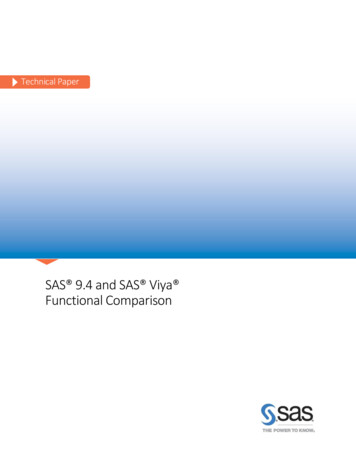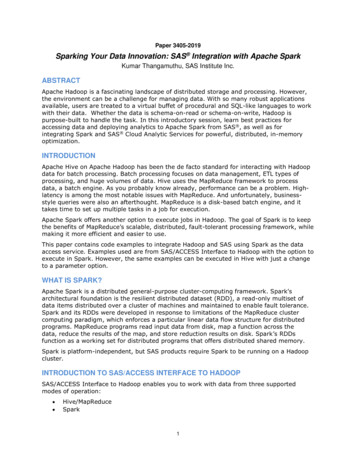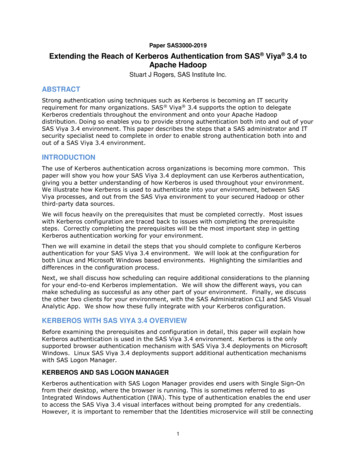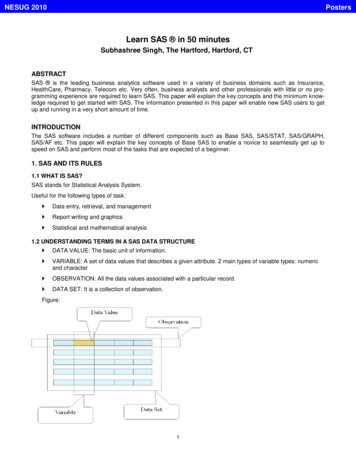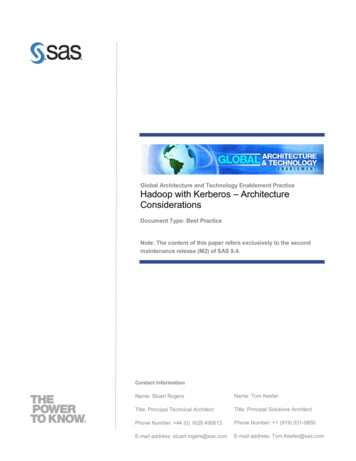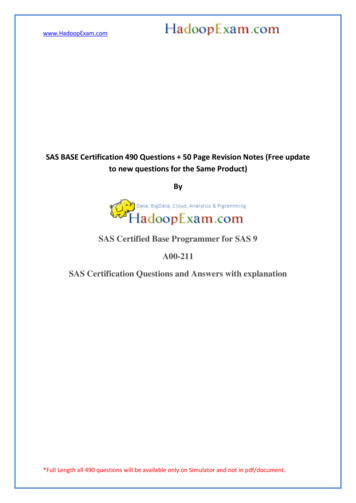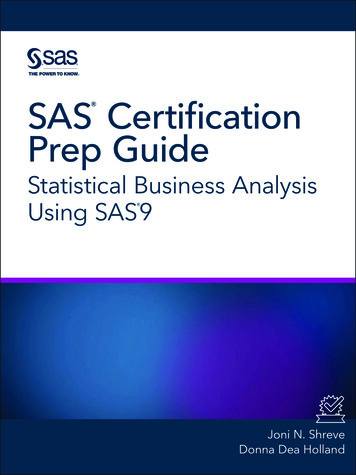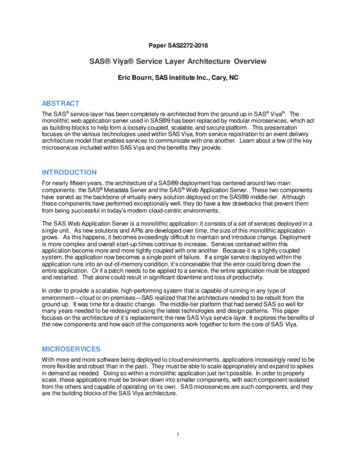
Transcription
Paper SAS2272-2018SAS Viya Service Layer Architecture OverviewEric Bourn, SAS Institute Inc., Cary, NCABSTRACTThe SAS service layer has been completely re-architected from the ground up in SAS Viya . Themonolithic web application server used in SAS 9 has been replaced by modular microservices, which actas building blocks to help form a loosely coupled, scalable, and secure platform. This presentationfocuses on the various technologies used within SAS Viya, from service registration to an event deliveryarchitecture model that enables services to communicate with one another. Learn about a few of the keymicroservices included within SAS Viya and the benefits they provide.INTRODUCTIONFor nearly fifteen years, the architecture of a SAS 9 deployment has centered around two maincomponents: the SAS Metadata Server and the SAS Web Application Server. These two componentshave served as the backbone of virtually every solution deployed on the SAS 9 middle-tier. Althoughthese components have performed exceptionally well, they do have a few drawbacks that prevent themfrom being successful in today’s modern cloud-centric environments.The SAS Web Application Server is a monolithic application; it consists of a set of services deployed in asingle unit. As new solutions and APIs are developed over time, the size of this monolithic applicationgrows. As this happens, it becomes exceedingly difficult to maintain and introduce change. Deploymentis more complex and overall start-up times continue to increase. Services contained within thisapplication become more and more tightly coupled with one another. Because it is a tightly coupledsystem, the application now becomes a single point of failure. If a single service deployed within theapplication runs into an out-of-memory condition, it’s conceivable that the error could bring down theentire application. Or if a patch needs to be applied to a service, the entire application must be stoppedand restarted. That alone could result in significant downtime and loss of productivity.In order to provide a scalable, high-performing system that is capable of running in any type ofenvironment—cloud or on-premises—SAS realized that the architecture needed to be rebuilt from theground up. It was time for a drastic change. The middle-tier platform that had served SAS so well formany years needed to be redesigned using the latest technologies and design patterns. This paperfocuses on the architecture of it’s replacement; the new SAS Viya service layer. It explores the benefits ofthe new components and how each of the components work together to form the core of SAS Viya.MICROSERVICESWith more and more software being deployed to cloud environments, applications increasingly need to bemore flexible and robust than in the past. They must be able to scale appropriately and expand to spikesin demand as needed. Doing so within a monolithic application just isn’t possible. In order to properlyscale, these applications must be broken down into smaller components, with each component isolatedfrom the others and capable of operating on its own. SAS microservices are such components, and theyare the building blocks of the SAS Viya architecture.1
BENEFITS OF MICROSERVICESThe loose definition of a microservice is an application that does one thing and does it well. Each area offunctionality is split into its own component, thus creating an extremely flexible environment wheremicroservices can be deployed independently of one another. Many of the intra-service dependenciesare removed so that these components are no longer tightly coupled. Without these dependencies inplace, individual services can be stopped and started without affecting the state of other services or theoverall system.What makes this design better than the previous monolithic approach? In plain and simple terms, smallerunits allow for more flexibility and control. Imagine the situation where a single microservice has run intoan out-of-memory condition, or a critical security fix needs to be applied to patch a vulnerability.Restarting a single microservice affects only users of that particular service at a given time; it is no longernecessary to restart the entire application stack. Restarts for a monolithic application can require asignificant amount of time and impact the entire system. For the SAS Web Application Server, a typicalrestart could take easily twenty or thirty minutes. Yet because microservices are smaller in size and theirfunctionality is isolated, restarts for them generally take a couple of minutes in order for the service tobecome fully operational.One primary goal of microservices is to reduce the possibility of a single point of failure. They aredesigned to be loosely coupled so that they continue to function at high capacity even when dependentservices are unavailable. If a service is down, you lose only the functionality that service provides, whilemost other actions continue to function as normal. There are a few exceptions to this rule that will bediscussed later, but in general, the impact of a down microservice does not affect the entire applicationstack. For example, if the microservice that supports delivering email messages to consumers is down,client applications continue to function as expected, with the exception of sending and receiving emails.The same cannot be said about the previous web application server. Because its services were tightlybundled together, any failures in a single component such as its mail delivery could have a significantimpact on the entire system.These concepts do not just apply to SAS microservices. Instead, they are part of a broad effort, knownas “The Twelve Factor App,” which aims to develop applications that behave properly in a cloudenvironment. The idea in general is to create services that can start up quickly, can be startedasynchronously from others, and can be gracefully shut down.SAS VIYA PLATFORMNow that we’ve discussed what microservices are and the benefits they provide, let’s dive into how theyare bundled together with other components to form the SAS Viya platform.At the heart of the SAS Viya architecture is a large collection of microservices. A single SAS Viyadeployment can contain 50 or even 100 different microservices, each working together to form a cohesivesystem. Each service is designed to provide a specific set of functionality, and these smaller sets ofwork-units enable applications to pick and choose which services they should deploy. By supporting an àla carte methodology, applications can deploy the set of services that are applicable to them. Forexample, SAS Visual Investigator can deploy a set of custom-designed fraud-related microservices thatwould not be applicable to any other application. Likewise, SAS Visual Analytics can deploy a set ofmicroservices related to data reporting that is specific to only that solution.2
Display 1. SAS Viya MicroservicesThere are certainly too many microservices to document here, but there are a few services that are worthcalling out. These core services provide a set of functionality that’s applicable to nearly all SASapplications. SAS Logon is a web application that enables users to authenticate to a SAS Viya deployment, usingfeatures built around OAuth 2.0 and OpenID Connect. Authorization manages a set of authorization rules that grant users access to various resources in thesystem. Identities retrieves information about identities (users and groups) defined within an environment. Configuration maintains a set of configuration properties that can be modified by administrators inorder to customize the behavior of a microservice. Folders provides a tree-based organizational structure for managing SAS and external content. Preferences provides storage and retrieval for application-based user preferences.SERVICE REGISTRATION AND CONFIGURATIONIn a cloud environment, the address of any microservice might vary. There’s no guarantee that a servicewill reside on the same underlying physical hardware each time the service is started. In addition, in anygiven deployment, the set of available microservices might be spread out across multiple machines.Given this setup, clients cannot possibly manage these addresses on their own. Instead, this burden fallson the SAS Configuration Server. Based on the Consul product from HashiCorp, the SAS ConfigurationServer acts as a service registration and configuration repository as it maintains a registry of all knownmicroservices defined in the system. When a microservice initializes, it is registered in a central location,which enables other services and clients to dynamically discover it at run time. The service registry’sresponsibility is to manage this information and provide the necessary information to determine whereincoming requests should be routed.In addition to address information, this registry also stores the current status of each microservice. TheSAS Configuration Server is designed to send regular health checks to all available microservices atconsistent intervals. These individual health checks over time give administrators an important view into3
the overall state of the system. Any time a particular microservice instance becomes unavailable—whether it’s because of network failure or a run-time error within the service itself—the change in state isdetected by the health checks and broadcasted to the administration application, SAS EnvironmentManager, which you will learn more about later.Another key feature of this component is that it provides a central repository for storing configuration datafor each microservice. Microservices are typically initialized along with their own set of defaultconfiguration settings that are persisted as key/value pairs. Many of these configuration settings can becustomized as needed by administrators. Yet, by using newer technologies—including the SpringFramework and Spring Cloud projects—many of these configuration properties can be dynamicallyrefreshed within a running microservice instance without requiring any manual restarts. As an example,suppose that the logging levels for a microservice need to be modified in order to determine the rootcause of an unexpected error. Since the log levels for all microservices are managed via standardconfiguration properties, updating the value from INFO to DEBUG dynamically triggers a refresh withinthe service. From then on, subsequent requests to that service log all messages based on the updatedsettings. All this is accomplished without requiring any downtime from manually having to restart aservice. Compare that to the SAS 9 approach, where any change to similar logging levels required anentire restart of the SAS Web Application Server.COMMUNICATING WITH SAS VIYA MICROSERVICESThe SAS 9 architecture relies heavily on proprietary APIs. Developing a client application to interact withthe SAS Metadata Server, for example, can only be done by using a collection of Java APIs, SASmacros, or DATA step functions. Writing a batch utility can involve spinning up a Java Virtual Machineinstance, regardless of how simple or complex the operation is. This certainly is not very efficient orportable.SAS Viya completely changes this model. Those proprietary APIs have all been replaced by industrystandard conventions, such as HTTP and REST. Regardless of whether the client is a web application ora batch script, communication with any SAS microservice is processed in a consistent manner. Clientsneeding to fetch information about the availability of a given resource on the system all use the samemicroservice to do so.Display 2. HTTP Requests between Clients and MicroservicesWhy choose REST? HTTP is a standard protocol. A resource is accessible via a URI by using standard HTTP methodssuch as GET, PUT, POST, DELETE, and so on. RESTful services open up access to all clients, regardless of the language or platform involved.Client applications can be written in Java, Go, C, Python, and so on. The typical data transfer format4
used by all microservices is Javascript Object Notation (JSON). Clients and services no longer have to stay in lock-step with one another. Services are free toversion independently of clients, as long as they remain backward compatible. More on this will bediscussed later, but services can even change their data model between versions without impactingclients. Each microservice is stateless; neither the client nor the server is required to store information acrossrequest boundaries.Output 1 shows an example using the curl command line utility for submitting a request to the RESTAPI for the SAS Identities service in order to retrieve information about the current authenticated user.The value of “TOKEN-VALUE” represents a valid OAuth2 token that enables a user to authenticate to thesystem. curl ser -X GET -H"Accept:application/json" -H "Authorization: Bearer TOKEN-VALUE"{"version": 1,"id": "demo user","name": "Demo User","description": "User account for demos only","creationTimeStamp": "2018-01-01T12:00:00.000Z","modifiedTimeStamp": "2018-01-01T12:00:00.000Z","providerId": "ldap","state": "active","links": [{"method": "GET","rel": "self","href": "/identities/users/demo user","uri": "/identities/users/demo user","type": "application/vnd.sas.identity.user"}]}Output 1. Output from a Request to the Identities serviceActing as the front door processing each of these requests is the Apache HTTP Server. Each SAS Viyadeployment consists by default of a single Apache HTTP Server that is capable of serving all dynamicand static content processed by each microservice in the stack. The web server’s responsibility is tointeract with the SAS Configuration Server in order to determine where (which machine and whichmicroservice) to route all incoming requests to.INTRA-SERVICE COMMUNICATIONAs discussed earlier, microservices are designed to have as few dependencies on other microservices aspossible. The motivation for this is to handle situations where if a particular service is down, it should notcritically impact any other service or application that depends on it. While services are allowed to5
communicate with one another via standard HTTP requests, these requests are typically processedsynchronously and end up tightly coupling the services together.To facilitate the decoupling of services, SAS Viya introduces the SAS Message Broker. The messagebroker—RabbitMQ—enables services to communicate with other services in an asynchronous mannerthrough an event-driven architecture. A given service can publish messages to the message broker whileother services, acting as consumers, can choose to react or ignore them. A service that publishes thesemessages does so in a “fire and forget” model in which they are not aware of or concerned about who islistening on the other side. Their goal is to publish a message that a particular event or action hasoccurred, but they do not need to worry about who the consumers of the message might be or whatactions those consumers might take when the message is received.In order to achieve this model, microservices communicate with the message broker via the AdvancedMessage Queuing Protocol (AMQP). Messages are published to one or more exchanges within thebroker, and queues owned by various microservices listen for any incoming messages on an as-neededbasis.The sas.application exchange serves as the main bus within the message broker. Messages are sent tothis exchange every time a resource is accessed or updated. In fact, each microservice is designed suchthat any HTTP request it receives automatically publishes an event indicating which resource wasaffected, who issued the request, what action occurred, and when the action took place. After theypublish the message, their work is done. On the receiving side, however, consuming services can use acustom routing syntax to indicate which messages they need to listen to.Display 3 illustrates what this flow looks like within some SAS microservices. The Folders serviceprovides an organizational structure for content in which references to specific content resources arestored within folders. Any time one of these resources is updated, the Folders service must be notified inorder for it to update its reference. If a report is deleted within the Reports service, the Folders service isnotified of this action so that it can properly clean up any references it might have related to that report.Other services might even have their own need to listen to that same message about the reporting beingdeleted. For example, the Audit service must also consume these messages in order to properly recordwhen resources are modified.Display 3. The SAS Message Broker6
A SAS Viya deployment consists of multiple exchanges that aid in delivering alert notifications and evenmonitoring metric information on the system. Regardless of which exchange is used to publish themessage, the SAS Message Broker assists in enabling asynchronous intra-service communication whilenot forcing services to be coupled to others.DATA PERSISTENCEIn a cloud environment, microservices can be started or stopped at unknown times. They must complywith the contract of being completely stateless in that nothing is shared. State information cannot bestored within a service at the risk of losing important information when a service becomes unavailable.Storing information within the file system itself isn’t an option, as it’s conceivable that when a servicecomes online, it could be located on a completely different machine. Therefore, it is imperative thatservices use a different approach for data persistence.Microservices must also be designed to manage their own storage needs. SAS follows the paradigm ofpolyglot persistence, which means that each service can pick and choose its persistence model as it seesfit. Services can use the tools and components that are ideal for their usage. Technically, this meansthat a microservice can even change its underlying persistence model in future releases. And sinceservices are bound to a backward-compatibility contract, any change like this would happen internallywithin the service without impacting any downstream consumers.The SAS Infrastructure Data Server serves as a central transactional storage mechanism for anymicroservice. The server is based on PostgreSQL, and although it is not used by every microservice inthe SAS portfolio, it is used to store a wide variety of data, from authorization rules to audit records tocontent folders and their membership information. Data within the service is split into separate schemasper microservice, thus giving each service the necessary flexibility in how its data should be persisted.Standing between the SAS Infrastructure Data Server and SAS microservices is the open-sourcesoftware Pgpool-II. Pgpool-II acts as a proxy in order to determine how client requests are routed to theunderlying database, while providing support for connection pooling, load balancing, and automaticfailover. If a single server instance is brought down, it’s the Pgpool-II proxy that determines how therequest should be sent to the other set of remaining servers.SCALING AND HIGH AVAILABILITYWhat happens in production environments when an application becomes a bottleneck because demandhas increased drastically? Or when the host machine that an application is running on experiencesproblems such that it’s now a single point of failure? In the world of monolithic applications, scaling forperformance or high availability can be achieved by replicating the entire monolith application. Given thesheer size of these applications and the resources they demand, scaling these can be an expensive task.With microservices, however, this feat becomes much simpler. Individual services can scaleindependently of others on an as-needed basis. For example, if demand on the Authorization servicecontinues to increase, scaling is as easy as deploying an additional instance of the service to anothermachine. After that service instance has been started successfully, it is registered within the SASConfiguration Server and becomes available for receiving requests. Simply by deploying individualservices to other machines, without any additional configuration required, you now have a much moreresilient environment.In order to guard against unexpected issues, such as hardware, operating system, or network failures, itis recommended that instances be distributed across multiple machines. Deploying multiple instances ofeach service results in a highly available and more robust system that requires less attention in the eventa failure occurs.7
Now that we’ve discussed how to scale the individual microservices, what about the infrastructurecomponents mentioned earlier? Most of these components have some support for high availability, andthe concept is generally the same for each: Deploy multiple instances of the server as a cluster acrossdifferent machines, whether it’s the SAS Message Broker or the SAS Infrastructure Data Server.We’ve learned already about the importance of a microservice being stateless. There are occasions,however, where cached data needs to be distributed across multiple service instances. For example, asingle microservice might need to create an in-memory cache of artifacts in order to reduce the frequencythat it needs to retrieve the information from a database. If this same service is deployed in a highavailablility system, that same cache would need to be replicated across the other service instances. Tosolve that problem, SAS Viya deploys two servers, the Cache Locator and Cache Server. Both of theseare microservices built on top of the Apache Geode project, where they provide a peer-to-peer orclient/server model for replicating cached data. No matter which service instance processes an incomingrequest, it is guaranteed to access the same cached information across all instances.ADMINISTRATIONWith so many components and services involved in any given SAS Viya deployment, administrators needa consolidated view to manage and monitor the overall state of their environment as well as troubleshootproblems. The SAS Environment Manager provides this consolidated view. It offers a unified approachfor customers needing to perform administrative tasks in their SAS environment. The followingcapabilities are supported by this application: providing a monitoring dashboard indicating the state and health of individual microservice instances managing and controlling authorization to various resources in the system, from folder content to CASlibraries viewing the set of identities defined on the system customizing the configuration settings for individual microservicesSAS Viya also provides a collection of command-line interfaces (CLIs) to perform many of these sameadministrative tasks. These utilities enable users to perform administrative functions without requiringaccess to a web-based application such as SAS Environment Manager. Each command is accessible viathe sas-admin CLI as individual plugins, including the following: sas-audit sas-authorization sas-folders sas-identitiesSimilar to the REST API example earlier (Output 1), Output 2 below contains an example of how to usethe sas-identities CLI in order to display information about the current authenticated user. ./sas-admin identities whoamiIdNameTitleEmailAddressesPhoneNumbersdemo userDemo UserSales executive[][]8
1-01T12:00:00.000ZOutput 2. sas-identities CLI outputCONCLUSIONThe architecture of SAS Viya is a drastic change compared to the monolithic approach used in SAS 9.By leveraging the microservices architectural pattern, the SAS Viya service layer becomes a morescalable and flexible system, one that can be deployed in any type of environment, including moderncloud-based systems. Newer technologies and design patterns help position the service layer to besuccessful for future generations of SAS solutions.REFERENCESSAS Institute Inc. 2018. SAS Viya 3.3 Administration. Cary, NC: SAS Institute Inc. inedoc/viya/index.html.SAS Institute Inc. 2018. SAS Viya 3.3 for Linux: Deployment Guide. Cary, NC: SAS Institute Inc.Available: a/index.html.Wiggins, Adam. “The Twelve-Factor App.” Available: https://12factor.net/. Last modified 2017. AccessedFebruary 10, 2018.ACKNOWLEDGMENTSThe author would like to thank Tony Dean and Joel Byrd from SAS Institute Inc. for the valuablecomments they had to offer on this paper.RECOMMENDED READING Hamrick , Danny. 2018. “Command-Line Administration in SAS Viya .” Proceedings of the SASGlobal Forum 2018 Conference. Cary, NC: SAS Institute Inc.CONTACT INFORMATIONYour comments and questions are valued and encouraged. Contact the author:Eric Bourn100 SAS Campus DriveCary, NC 27513SAS Institute Inc.(919) 677-8000Eric.Bourn@sas.comSAS and all other SAS Institute Inc. product or service names are registered trademarks or trademarks ofSAS Institute Inc. in the USA and other countries. indicates USA registration.Other brand and product names are trademarks of their respective companies.9
monolithic web application server used in SAS 9 has been replaced by modular microservices, which act as building blocks to help form a loosely coupled, scalable, and secure platform. This presentation focuses on the various technologies used within SAS Viya, from service registration to an event delivery .


